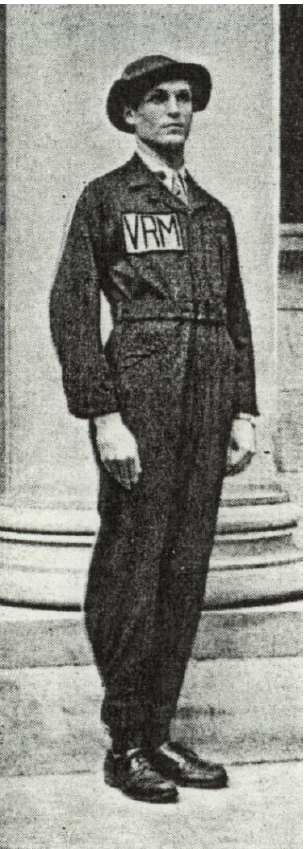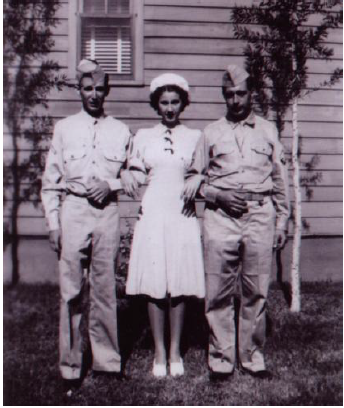Virginia Reserve Militia
Stafford provided troops for war against the Axis Powers of Germany, Japan and Italy. For example, William Weedon Cloe’s oldest son, of the same name, served in the Army engineers. The Cloes received $8,500 compensation for their farm and moved further south in Stafford. Weedon Cloe took a job with the Richmond, Fredericksburg, and Potomac Railroad as station manager. He joined the Virginia Reserve Militia. War heroes came in all shapes, sizes, genders and ages.
World War II also fostered the concept of “A Nation at War.” A local company of the Virginia Reserve Militia (VRM) was formed to guard vital transportation nodes in the county. On May 18, 1942, Brigadier General S. Gardner Waller, Virginia’s Adjutant General, announced the mission of the VRM:
To furnish immediate local protection against saboteurs and raiding parties, destroying them or serving as a holding force, pending the arrival of better equipped troops.
In today’s parlance, they were a tangible force in Homeland Security. In the world of 1942 they were a practical recognition that German saboteurs were capable of infiltrating and disrupting the American war industries and economic system — a month after the VRM was created, German sabotage agents infiltrated at Long Island, New York, with plans to operate along the U.S. east coast. Each county or city was to form one company, commanded by a captain and two lieutenants, with 50 enlisted men. Companies consisted of two platoons of four squads each. Each squad, lead by a corporal, was organized by locality. Each VRM member had to own an automobile capable of transporting an entire squad at one time and the company was required to organize transportation so that squads arrived at their posts together. Each member also had to own a telephone and his own rifle or shotgun with ammunition. The Adjutant General’s Office cautioned that each man should be a reliable communicator and source of intelligence as well, “The great value of the Virginia Reserve Militia lies in the ability to strike raiders, particularly parachutists, before the enemy has had the opportunity to organize for attack.” VRM Membership required U.S. citizenship “of unquestionable loyalty; ages 16-35 years (parental consent for those under 18); physical fitness; and required weapon, ammunition, telephone and automobile (capable of transporting five passengers at 40 miles per hour). Three officers and 43 men were needed for unit status.

VRM “Minute Man” — “Minute Men” wore a forest green fatigue-type jump suit, floppy fatigue hat of the period, and low-quarter shoes. The large letters “VRM” were sewn over the right breast in line with the left upper pocket. The uniform, which cost $3.95 for the coverall and 95 cents for the hat, would add the appropriate rank or chevrons for officers and noncommissioned officers. A far cry from the stuff of glory and a clear break from earlier days, the uniforms were at least functional. [Richmond News-Leader]
The Stafford VRM “Minute Men” Company mustered at Falmouth High School on October 17, 1942. Selected captain was Daniel M. Chichester and his lieutenants were Frank Moncure and Herbert L. Thornton. First sergeant was Clem Goodman and Norman Brown was a sergeant. As there was no VRM officer to administer oaths, Justice of the Peace Fisher swore them in as special police. Four posts were outlined in Falmouth. Falmouth Boy Scouts were used as messengers. The local newspaper soon reported “Minute Men Unit Ready in Stafford” with 46 men and three officers on the initial roster. In addition to Chichester, Moncure, and Thornton, the following family names were listed (some may be misspelled): Armstrong; Bayliss; Beagle; Beckham; Bolton; Brickert; Bridwell; Brooks; Brown; Catlett; Cleverley; DeShazo; DeShields; Flack; Goodman; Gordon; Green; Haleman; Harris; Heflin; Jett; Lunsford; MacGregor; Massie; McDaniel; Miller; Huntington; Monroe; Musante; Patton; Pearson; Snellings; Stone; Sullivan; Thomas; Tulloss; Walker; Wirman; Wyne; and Young. They were “Stafford Company No. 90, Virginia Reserve Militia (Minute Men).” Others soon joined and a full strength of 63 officers and men was achieved. Captain Chichester sent a committee to confer with the Board of Supervisors to see about helping with the $4.90 cost for each enlisted man’s uniform. Company headquarters was established at “Four Gables” on U.S. 1, four miles north of Falmouth. Sergeants were soon designated and, not surprisingly, the name of W. Weedon Cloe of Stafford appeared, as did Norman B. Brown of Falmouth. As further insight into Weedon Cloe’s character, he was 44 years old (thus exceeded the maximum VRM age) when he joined the VRM shortly after his home had been confiscated. Corporals were John W. Patton (Berea); H.A. Flack (Roseville); William N. Cleverley (Falmouth); B.J. Musante, Jr. (Falmouth); Charles E. Walker (Falmouth); James E. DeShazo (Route 2, Fredericksburg); E. Dallas Wyne (Falmouth); J. Lewis Monroe (Garrisonville); Andrew Truslow (Stafford); and J. Churchill Gordon, Jr., (Stafford). New family names appeared on the roster of privates during the company’s service were: Biglin; Bradshaw; Castle; Cox; Decatur; Dillon; Duncan; Homes; Karz/Kurz; Knight; Lockhart; Lowrey; Perkinson; Price; Solomon; Steward/Stewart; Timmons; Vaughn/Vaughan; Wine; and Woodwar. By December 1942 William Cleverley was added as staff sergeant; Robert Bridwell of Garrisonville was a sergeant; and Alaric R. MacGregor of Stafford and Leonard C. Haleman of Falmouth were added to the corporals.
The company received Training Memorandum No. 1, detailing possible chemical warfare agents they might be exposed to, their identification, and treatment. The company’s posts were at “critical points” and two-three men were assigned to each. Highway bridges along U.S. Route 1 over Aquia Creek, Austin Run, Accokeek Creek, and Potomac Creek were specified in addition to the Falmouth Bridge over the Rappahannock. Railroad bridges of the R.F.& P. over Aquia Creek, Accokeek Creek and Potomac Creek were also listed as critical points in Stafford. Orders reflect that men were mustered-out when ordered to active service in the U.S. Armed Forces. Of course, most
Staffordians who served were among 16 Million Americans in the U.S. Armed Forces during World War II.

Sometimes the service of a particular soldier may be lost to posterity. This is particularly the case for young men who were killed-in-action or missing-in-action, as they seldom left descendants and, after their older family members had passed-on, the community at large might forget them. One such soldier was Technical Sergeant Leonard A. Jones, who served in the 7th U.S. Infantry in the 3rd Infantry Division in World War II. Jones was from the Hartwood District of Stafford County. He was killed-in-action on September 24, 1944, in Southern France and received the Silver Star Medal, the nation’s third highest award for valor. His heroism is reported in the citation which is shown below. Unlike many of comrades, he has a gravestone in his home cemetery at Hartwood Presbyterian Church, a scene of fighting in the Civil War 78 years before America entered World War II. On June 6, 2010, the anniversary of the D-Day Invasion, the Stafford County Cemetery Committee honored Jones at a graveside memorial ceremony. The 24-year-old Sergeant Jones had given everything he was or would ever be for his country.

